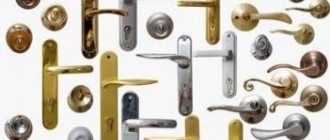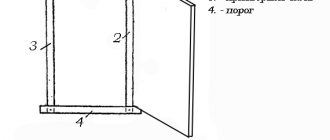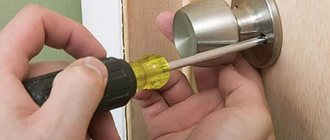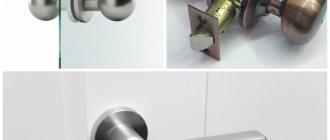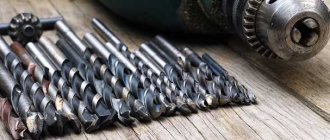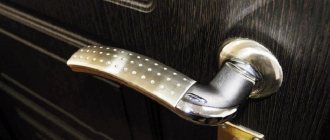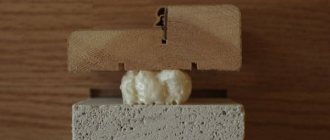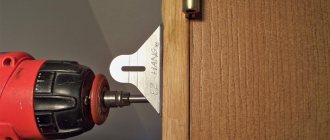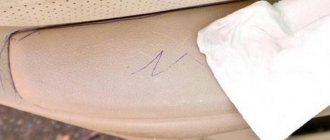Interior doors are installed in every apartment, private residential building or office space. These interior elements perform aesthetic, enclosing and soundproofing functions. The operation of products involves their periodic opening and closing, which is carried out using a locking mechanism and handle. These parts often become unusable after several years of use due to physical wear and tear. To change a door handle, it is not at all necessary to turn to professionals for help. Every home craftsman, having a minimum set of simple tools at hand, can independently disassemble and remove the handle from an interior door and then replace it.
Rice. 1. Assortment of handles for interior doors
Classification of door handles
There are several criteria for separating handles, which are based not only on the design features of the device, but also on the principle of operation. So, the first group is the differences in the installation method. There are two positions here:
- mortise models;
- invoices.
It is clear that the first one cuts into the door leaf, for which a hole must be made in the latter. The second is simply attached to the door using self-tapping screws or self-tapping screws.
The second group is the purpose of the door accessory. There are also two positions here: entrance and interior. That is, the first are installed on the entrance doors, the second on the interior doors.
The third group also defines two positions that differ from each other in their functionality or, more precisely, in their operating principle. There are also two subgroups: rotary and stationary. The former have their own additional division, a kind of subgroup, which again has two positions:
- push-type handles;
- rotary
Push and turn handle Source interyerum.ru
It is clear that when the question is raised of how to disassemble the door handle of an interior or entrance door, it is necessary to take into account the design features of the device. And they correspond to the type of products offered, the classification of which is indicated above.
Therefore, to make it clear what design features we are talking about, we list them, referring to some models of door handles.
Design features of door handles
Let's start with stationary ones. They are produced without any additional elements. That is, there are no latches or locks in their design. This is the simplest option. They are simply applied to the door leaf and secured through the mounting holes with self-tapping screws.
Such handles have only two purposes: moving the door and filling it decoratively. Therefore, manufacturers today offer a huge range of them in terms of sizes, shapes, and colors. They can be one- or two-sided. The latter are connected to each other by the so-called axial element. As for the doors on which they are installed, these are interior or balcony doors. Stationary handles are rarely mounted on entrances.
Stationary door handle Source v-dver.ru
Now about push models. Purely structurally, these are two L-shaped levers. They are connected to each other by a steel rod passing through the door leaf. The design of the product contains a tongue that locks the door by entering the hole in the door frame located opposite the end of the leaf. Such handles are used on both entrance doors and interior doors. Push-type models have a large number of advantages, where we would like to highlight a long service life and high reliability.
The next type is rotary. More often, manufacturers make such pens either in the form of a ball or in the form of a button. The diameter of the device is 50-60 mm. There is a keyhole in the center. It can be located on each handle or only on one, that is, on a certain side. The model received its name only because the door can only be opened by turning the handle around its axis. Manufacturers often equip this rotary accessory with a lock. Such models are usually installed in toilets and bathrooms. Let us add for information that such handles are called “knobs”.
Unfortunately, it should be noted that rotary knobs have low strength and service life. The reason is a large number of rotating parts that wear out quickly.
I would like to separately list the components of the rotary and pressure devices, so that in the future it will be easier to understand how to disassemble the handle of an interior door. The pen contains:
- latch;
- socket, also known as a bar;
- square pin;
- a decorative flange that covers the mounting points;
- a spring with which the handle returns to its original position;
- a limiter that limits the movement of the handle when it is pressed;
- retaining ring;
- fasteners.
The devices are additionally equipped with a key, which is used to press and remove the mechanism, as well as keys used to remove and install the handle on the interior door.
What are they?
Manufacturers make handles in the form of complex and simple mechanisms. In the panel itself you can find two types of models - overhead (not mortise) and mortise. They are divided into several more subspecies:
- Push (with latch) . These are the second most popular subspecies. The name exactly describes the mechanism of operation: after pressing with your hand on the rotary lever, the parts rotate and the door opens.
- Hidden . For installation on sliding door systems. For example, their relevance increases when mounted on a coupe. When the doors move, the hidden handle does not interfere and does not harm the walls, the panel itself, or wallpaper.
- Knobs . They have a rotating mechanism. They are easy to install, have been used for a long time, and do not lose their relevance.
But very often interior door structures are equipped with rotary and stationary mechanisms.
Rotary
This is a handle for unlocking the door leaf. The design includes:
- holder;
- handle;
- retainer
The holder activates other elements, the latch locks the locking tongue. Swivel ones are very convenient, because they are round in shape. However, if the ball-shaped handle is damaged, the door cannot be unlocked.
Knobs have become in widespread demand. This is a round or oval handle with a built-in lock. It requires making a hole in the door panel. The keyhole is located on both sides. But some models imply the construction of this well with only one (with a one-way latch and plug).
Advantages of rotary door handles:
- Safety . Adults and children do not injure their hands when using the handle.
- A wide range of . Thanks to the varied designs, it is easier for the consumer to choose an element. For example, accessories may have glass inserts and rhinestones. They emphasize the beauty of the interior and give the door leaf elegance and individuality.
- Thoughtful mechanism . The door structure is locked both from the outside and from the inside of the room.
Disadvantages: rapid deterioration of internal parts. Sudden movements lead to jamming, which will require dismantling and repair of the handle.
Stationary
These are simple structures that do not have a locking mechanism or parts moving relative to each other. They look like buttons and staples. They can move the panel in the desired direction. Strength, reliability, durability depend on the material.
Advantages:
- Simple design . There are no mechanisms, which means there is nothing to break.
- Long service life . The surface is suitable for any type of restoration.
- Wide choose . Models - modern or antique. The latter give the interior solidity and luxury.
- Easy installation . It is enough to screw it with self-tapping screws to the door leaf.
Structures made of plastic, metal, wood do not require special care. But they have the only drawback - they do not lock the doors, leaving the room accessible for entry at any time.
How to remove
Dismantling door hardware is not a problem if you have the necessary tools and minimal theoretical knowledge of the mechanism. You can remove the door handle of an interior door yourself without calling a technician. To do this, you must follow the instructions:
- Support and secure the door.
- Pry the decorative flange with a knife and pull it out a little. Underneath there are fasteners that need to be unscrewed.
- There is a spring-loaded locking pin on the decorative flange of the pressure device. Press it in with a screwdriver. In rotary models, the pin is located inside the body. In order to get to it, insert a key or awl through the technological flange hole. If the pin cannot be felt, rotate the flange until it contacts it.
- Press the pin while pulling the door device.
- Unscrew the mounting screws.
- Separate the inside of the door element from the outside, remove the handle and decorative flange.
- If you need to remove the latch and replace it or repair it, unscrew the screws securing it to the side of the door block, remove the bar, then the mechanism.
When installing accessories to another location, you should not disassemble them for spare parts. It is attached to the door structure in the reverse order. If the handle or latch needs to be repaired or replaced, further disassembly is performed.
How much does it cost to replace?
Often, users turn to specialists for help. For example, when it is impossible to carry out the replacement yourself, in the absence of experience, tools, or lack of time. Specialists put forward their price list for services. Approximate prices:
- replacing a mortise lock without disassembling the door - from 1,500 rubles;
- replacement of a mortise lock with disassembly - from 2,000 rubles;
- replacement of a rim lock - from 1,000 rubles;
- replacement of a door handle of any configuration and on any basis - from 1,000 rubles.
The cost of services may vary depending on the region, company, and professionalism of the craftsmen. But experts recommend that you carefully consider the choice of organization. Too low prices indicate a lack of experience or dishonest fulfillment of one’s obligations.
Dismantling different types of handles
Before you remove a round or other type of handle from an interior door with your own hands, you need to understand its mechanism and carefully study the assembly instructions.
The procedure for assembling/disassembling the fittings is not complicated or time-consuming. Anyone can handle this task. The main thing is to properly organize the work process and first find out the reasons for the failure of the fittings.
Push without lock
Lever handles are often mounted on the leaves of interior door blocks. Most often in such products the rod breaks. Therefore, you need to know how to dismantle this type of fittings.
The pressure handle bar is secured to the blade with screws, which are unscrewed first. Next, the broken rod must be pulled out using pliers.
If the hardware cannot be removed, you need to find a pin or screw, press it and pull the door handle towards you. Instead of the old structural element, a new one is installed in the reverse order.
Plastic
Plastic fittings are easier to dismantle than other types of products. First you need to rotate the overhead strip, which is located under the plastic handle, 90 degrees. There are screws at the bottom that need to be unscrewed to remove the broken handle.
When purchasing new hardware, it is important to choose the same model from the same manufacturer. It is important that the fasteners and screw holes match.
Push with lock
The push handles used in conjunction with the lock are not very reliable and last a fairly short period of time. But if the latch functions normally, then it is not worth changing.
The algorithm for dismantling the product is also quite simple. First, the fastening screw holding the handle to the canvas is unscrewed and it is removed. Next, you need to lift the trim strip using a knife. It has a special connector for this. But this must be done carefully so as not to damage this part.
To remove the lock, you need to unscrew the four screws that are located under the bar.
Round
These products are distinguished by the fasteners that hold them to the door leaf. Round handles (knobs) are made without pins. They are equipped with spring clips and are included in the door delivery set. A special key is provided for them. If it is missing, then the spring part can be pressed with a nail or other thin object.
If there is no access to the latch, the flange is removed. To do this, you need to carefully pry it off with a sharp knife. The part is then rotated 180 degrees so that the spring component fits into the hole. A characteristic sound should be heard. Next, you need to press the latch and pull it towards you. After removing the flange, the decorative screws are unscrewed.
Stationary
Standard door handles are made in the form of a square, round bar or in the form of a bracket. Such products are attached to the door leaf with ordinary screws. The inner and outer handles are mounted on one rod. When you turn the handle on one side, it turns on the other at the same time.
To remove such a handle, you simply need to unscrew the screws that hold the structure bar in place. After this, the fittings are easily removed.
Push with magnetic lock
Before removing the round push door handle with a magnetic lock on the interior door, it is recommended that you familiarize yourself with the design and installation rules.
Such products are mounted directly on the door leaf; the mechanism operates almost silently and is characterized by a long period of operation. Most often, such models are installed on door blocks for children's and bedrooms.
After prolonged use or rough handling, the latch may become warped or begin to jam when exposed to a magnetic element. Therefore, to adjust the mechanism or completely replace the fittings, you have to remove them.
To do this yourself, you need to find a special hexagon connector at the bottom of the trim strip. The base of the structure is unscrewed with a key and left in a hanging position. Next, you need to find another hole in the moving part, unscrew the screw and remove the fittings.
After this, the rod axis will become available. Similar actions are performed on the other side of the door leaf. Next, you need to unscrew the main fastening element holding the handle and remove it. Now you can use a screwdriver to remove the magnetic mechanism located on the end of the door.
Magnetic
Magnetic latches have a fairly simple structure, due to which they have a long service life. The most silent of existing types of locks. The principle of their operation is based on the action of a magnetic field. Available in two types:
- Simple (passive) - consist of a metal plate mounted in the grooves of the door frame and a magnet installed in the lock. No need to press the handle. The downside is that fixation by gravity alone is not reliable enough.
- Active - with bolt . Reliably fix the door leaf in the closed position. The magnet is installed in the jamb, and a lock with a bolt (retractable tongue) is cut into the door. When the leaf is open, the latch is pulled inside the door leaf. The doors close, the tongue approaches the magnet, jumps out under the influence of gravity and falls into the groove. To open the door, you must press or turn the handle.
Caring for fittings
Replacing the handle is a simple process. However, proper care of the fittings will guarantee durability and uninterrupted functionality. Intensive use causes locking mechanisms to become unusable. They wear out, get old, don’t turn, don’t latch. Care instructions:
- Cleaning . Wipe the mechanisms from dust in a timely manner with special cleaning agents. It is not recommended to use substances that contain aggressive acids, alkalis and abrasive particles. Door hardware suffers from such components and quickly rusts. After cleaning, wipe it with a dry, clean cloth.
- Checking mechanisms . If the user feels that the handle is loose, then it needs to be tightened. Inattention and negligent attitude will lead to the final failure of all mechanisms present in the design.
- Additional door care . In damp rooms it is susceptible to damage by mold and mildew. Wooden panels are eaten by insects. Moisture-proof compounds are used. When the panel swells, the door lock rusts and is squeezed out. The result is that the structure does not close, the handle spoils the slopes and walls.
- Careful handling . Careful, careful use of the handle does not cause mechanical damage to it. Jerking or forcefully slamming the door will damage the design and functionality.
- Lubrication, inspection for cracks. If the handle sticks when turning, it is necessary to lubricate the mechanisms with special oil. The composition is sold in construction stores. Over time, the panel near the locking element cracks and gradually forms gaps. Typically, such consequences appear when the handle is inserted carelessly.
Solve the problem in several ways:
- Seal small cracks with silicone sealant and putty so that the new layer does not protrude beyond the panel. Otherwise the door will not close. Wait until completely dry and sand the surface. Choose the color of the putty mixture to match the tone of the door surface.
For large gaps, use wood chips made of the same material as the doors. Select wood chips with identical gap dimensions. Carefully insert, cover with sealant, then putty. You can fix the element with construction glue. The main thing is that it does not protrude beyond the boundaries of the piece. After drying, check the door to ensure it can close completely.
Attention. Some models have hard-to-reach elements. It is not always possible to properly disassemble the mechanism in order to lubricate all its parts. You can make the process easier if you use a convenient attachment in the form of a thin and long tube or brush with natural fibers.
Roller
The design of this type of latch is very simple: a spring-loaded ball (roller) is installed in the end part of the lock.
When closed, it slides into the groove, holding the door. It takes some effort to open it. A roller latch is a universal device suitable for door structures made of various materials - wood, plastic, glass, as well as any type of door, even pendulum and sliding.
The advantages of this type of latches include:
- simplicity of design and installation;
- ease of use;
- wear resistance;
- reliability;
- long service life;
- products are low cost.
The downside is a loud click when closing the door.
Common causes of breakage and repair of locks on interior doors
In addition to contamination and drying of the lubricant, which lead to increased wear of the metal parts of the locking mechanism, the locks may also have other malfunctions.
For example, an electromagnetic lock may fail for the following reasons:
- short circuit in the circuit;
- button sticking;
- lack of supply voltage;
- reader failure;
- Damage to the electromagnet or control unit.
Problems can occur in the lock cylinder when there are:
- abrasion of the rotary cam (if the manufacturer saved money and did not use hardened steel);
- wear on the side or top pins;
- wear of the steering cam axis;
- foreign objects getting into the pin mechanism.
The lock of doors between rooms may require repair if the operating springs are weakened, wear appears on the plates, or decorative elements are damaged.
Locking latches
The locking latch is usually combined with halyard or magnetic devices.
The mechanism makes it possible to lock the door (usually on one side), preventing it from being opened only with the handle. Most often this is a special wrap, located on the same bar with the handle or at some distance from it. On the reverse side, it is possible to open the locked door with a special key or press the latch through a secret groove. Latches of this type are widely used on doors of bathrooms and toilets.
Expert advice
Almost all experts, when removing and disassembling interior door locks, note several points that need to be paid special attention to.
- You can remove the spring manually or pry it off with a screwdriver, covering the mechanism with a rag or hand.
- It is important to wipe all parts of the mechanism with a dry, clean rag to remove old grease and assess the degree of wear, as well as the possibility of further use or the need for replacement.
- Before assembly, it is very important to lubricate all parts of the lock mechanism, including the spring, with special lubricant. This procedure contributes to longer, trouble-free operation of the product.
- Lubricant must be selected from a range of graphite options. Graphite-based substances are less susceptible to temperature changes, dust accumulation, etc.
In this article we examined the features of removing and disassembling interior door locks. However, before disassembling such products yourself, it is very important to read the relevant information in various sources and get advice from a professional technician.
Sources:
- https://furni-info.ru/kak-snyat-dvernuyu-ruchku.html
- https://m-strana.ru/articles/kak-razobrat-dvernuyu-ruchku/
- https://ODveryah.ru/furnitura/kak-razobrat-dvernuyu-ruchku
- https://o-dveryah.ru/zamki/kak-snyat-dvernuyu-ruchku-mezhkomnatnoy/
- https://okcomfort.com/dveri/zamena-mezhkomnatnoj-ruchki.html
- https://DomNaMne.ru/zabory/zamki/kak-pravilno-razobrat-zamok-mezhkomnatnoj-dveri
- https://stroy-podskazka.ru/dveri/zamki/mezhkomnatnye/kak-snyat-i-razobrat/
- 1
Criterias of choice
Having studied the main types of latches, we can formulate several rules for their selection:
- determine what degree of protection is needed for the door, whether a lock is needed;
- whether locking fixation is necessary;
- how important is quietness;
- what type of handle the mechanism will interact with;
- select the material from which the device is made.
The best materials for the latch mechanism are steel; for some, brass. Aluminum is too soft, and silumin is fragile. Plastic ensures silent operation of the device, but is easily deformed and damaged.
Installation process
Let's say you installed a new interior door. Now you need to cut the handle into it. Its functioning depends on the quality of the operating mechanisms and correct installation. Before talking about the installation process, we suggest you familiarize yourself with its components.
Knob-type door handle-latch diagram
- 1 – internal rotary handle;
- 2 – technological hole;
- 3 – spring clamp;
- 4 – lock button;
- 5 – handle shank;
- 6 – decorative flange;
- 7 – mounting plate;
- 8 – cylinder of the locking mechanism;
- 9 – decorative flange;
- 10 – external rotary handle;
- 11 – latch mechanism;
- 12 – plate for fastening at the end of the door;
- 13 – strike plate for the door frame.
